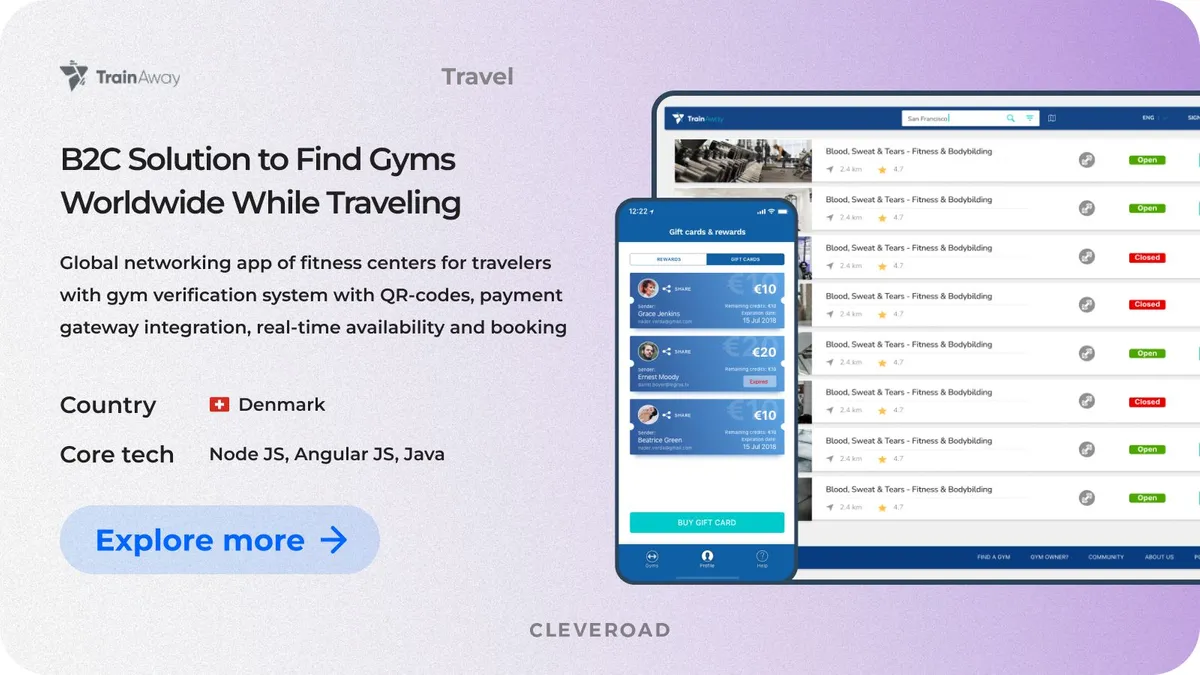Travel App Development Guide: Types, Features, and Cost
Updated 28 Jan 2025
23 Min
9197 Views
Traveling has been popular among people for all time so travel app development is in demand. People apply to mobile devices to find the right road, compare prices for accommodation and transport, book flights, and more and more. But if you’re serious about building a big-time travel app, you need to carefully choose the business model, your product features, and budget matters.
As a software development provider with hands-on experience in travel app creation, we’ve prepared this guide. You’ll discover what this app is, its operating mechanism, core feature set, the average cost for travel application building, and more. Let’s get started.
What Is Travel App Development?
A travel app development is a creation of a mobile or web application designed to assist users in planning, booking, and managing their travel experiences. It typically allows users to operate with flight and hotel reservations, itinerary organization, destination guides, and real-time updates on travel conditions. By integrating various travel services and information into one platform, it aims to provide a seamless and convenient experience for travelers.
The operation mechanism of a travel application starts with a user-friendly interface where travelers can search for and book flights, hotels, and rental cars. The app uses secure payment gateways to handle transactions. It also features itinerary management, allowing users to organize their travel plans in one place.
GPS and map services are integrated to provide navigation and local attraction recommendations. Push notifications keep users informed about flight status, weather updates, and travel advisories. Finally, the app employs data analytics to personalize suggestions based on user preferences and travel history, enhancing the overall experience.
The potential of the travel apps development on the market
The travel industry has undergone a significant transformation, with mobile apps becoming the go-to resource for modern explorers. This surge in popularity isn't without reason - travel apps offer unparalleled convenience, personalization, and travel information access, revolutionizing the way we plan and experience journeys.
Let's delve into the statictical data to understand the captivating rise of travel app development.
- The global travel market is expected to grow by $5.50 trillion from 2024 to 2028, with a Compound Annual Growth Rate (CAGR) of 18.52%.
- If talking only about the app market, the global travel app market is projected to experience substantial growth, with revenues expected to reach approximately $2 billion by 2027.
- The total number of international arrivals in the United States is projected to grow by 3.8% annually, reaching 94.6 million visitors by 2027.
- About 60% of mobile travel apps are used at least monthly.
As you can see, the growth of travel mobile apps is explained by the convenience, personalization, and information access they offer. This trend is fueled by user demand for features like real-time updates and easy booking, making travel apps a must-have for modern explorers.
The core travel app benefits
Let’s discuss the major reasons that make travel app development and usage so popular and advantageous for users.
Revenue generation. Travel apps can generate significant revenue through various streams such as bookings, advertisements, and premium features. With such an approach, you can earn commissions from service providers.
Brand recognition. You can build a strong brand presence in the tough travel business by providing a visually stunning and user-friendly app. This way helps establish trust and credibility among users of your travel app.
Data collection. Travel mobile application development enables you to collect valuable data on user preferences, behaviors, and trends. The said data can be leveraged to improve services, target marketing efforts, and make informed decisions.
Global reach. With the help of a travel app, you may reach a worldwide audience and grow your business beyond local or regional limits. International payment methods and multilingual support have the potential to draw tourists from all around the world.
Partnership opportunities. Mobile app development for travel opens up opportunities for partnerships with airlines, hotels, tour operators, travel agents, and other service providers. Collaborations can enhance your app’s offerings and increase its value to users.
Customer retention. A well-designed travel app can foster customer loyalty by offering personalized travel experiences, exclusive deals, and rewards programs. Loyalty programs can encourage repeat usage and increase lifetime customer value.
Types of Travel Apps
Let us explore the main types of travel mobile solutions divided by the services they can offer. We’ll dive deeper into their aims and core features as well as give you examples for each of the types used during the travel mobile app development process.
Flight booking apps
Apps for booking flights are made to make it easier for passengers to find, compare, and book flights. These applications usually provide a must-have feature set like:
- Seat selection
- Price notifications
- Flexible date searches
- Safe payment methods
The finest flight alternatives that fit their needs and budget may be found by users by browsing through a variety of airlines, departure timings, and rates. Popular examples of travel booking apps for flights are Skyscanner, Kayak, Expedia, and others.
Transportation apps
Transportation apps are a category of travel applications designed to facilitate various modes of transport for travelers, including ridesharing, public transit, car rentals, bike-sharing services, and online travel train ticket reservations.
Core features of this kind of app for traveling typically include:
- Real-time tracking
- Route planning
- Fare estimation
- Booking and payment integration
- User reviews
Examples of popular transportation apps include Uber and Lyft, Google Maps, and Turo. These apps significantly enhance the travel experience by providing convenient, reliable, and often cost-effective transportation solutions, enabling users to navigate and explore new destinations with ease.
Accommodation booking apps
Accommodation apps with booking options are specialized travel and hospitality applications designed to help users find, compare, and book various lodging options such as hotels, hostels, vacation rentals, and more. To build a travel app like this, developers need to incorporate the following core features:
- Comprehensive search and filter options
- User reviews and ratings
- Detailed property descriptions
- High-quality photos and maps to check locations
Examples of popular accommodation booking apps include Airbnb, Booking.com, and Expedia. These apps enhance the travel planning experience by providing convenience, a variety of choices, and personalized recommendations, ensuring users can find the perfect place to stay for their trips.
Read more about hotel booking app development in our guide to dive deeper into details of accommodation booking app building!
Travel planner apps
It’s a popular type of app for the travel industry designed to streamline and enhance the travel experience by organizing all aspects of a trip in one place. It is an app that offers a variety of core features like:
- Itinerary creation
- Booking management
- Destination recommendations
- Real-time updates on flights and accommodation
Some well-known travel planning apps include TripIt, Roadtrippers, and Google Trips. These apps embody the app idea of simplifying travel logistics, ensuring that travelers can focus more on enjoying their journey rather than managing the details. With features like collaborative planning and offline access, travel planner app development teams cater to both solo travelers and groups, making their product an indispensable tool for modern explorers.
Virtual tour apps
Virtual tour apps transcend static photos, allowing users to embark on immersive journeys through 360-degree panoramic images, high-definition videos, and interactive elements. Popular examples of virtual tour apps include Google Arts & Culture, YouVisit, and Lokal.
How to build a travel app of this type? Here are some of the core features you can use:
- Detailed virtual walkthroughs
- Integration of audio guides
- Informative pop-ups
- Compatibility with VR headsets
These types of travel apps and travel app development significantly enhance the travel experience by offering specialized services that cater to various needs and preferences. Whether you're booking a flight, finding the perfect accommodation, planning your itinerary, or taking a virtual tour, using these apps simplifies and enriches your travel journey.
How to Create a Travel App from Scratch
Creating a travel app from scratch involves a series of well-planned steps to ensure the final travel app meets users' needs and stands out in a competitive market. Here’s a comprehensive guide to travel app development process.
1. Define your app purpose
The first step in developing a travel app is to clearly define its purpose. Identify the specific problems your app will solve for travelers and the unique value it will offer. Consider whether your app will focus on booking flights, accommodations, creating itineraries, or providing travel guides.
Having a clear travel app idea helps streamline the development process and guides your decisions. Understand your target audience and their needs, as this will influence the travel app features you want to choose and design. A well-defined purpose sets a foundation for the rest of the development process.
2. Conduct market research
Conducting thorough market research is crucial to understanding the competitive landscape and identifying market gaps. To create a successful travel app, you should to learn about its strengths and weaknesses. You can gather insights from potential users through surveys or focus groups to understand their pain points.
This research helps in refining your travel app idea and ensures that your app addresses real user needs. You should stay updated with the latest trends in the travel industry to incorporate relevant features that appeal to modern travelers. Market research also aids in creating a strong marketing strategy for your travel app.
3. Find an outsourcing travel app development vendor
Bringing your travel app idea to life can be challenging, but outsourcing development offers numerous advantages. This stage of the travel app creation consumes you to gain access to a pool of experienced professionals, saving time and resources while leveraging their expertise. This allows you to focus on your core business strengths while a trusted tech partner translates your vision into a robust and user-friendly app.
Now, let’s check the points the effective travel app vendor should have:
- Experience in rendering quality travel app development services
- A strong portfolio of successful projects
- Client testimonials on the Clutch page and reviews to gauge their reliability and quality of work
- A proficient team of developers, designers, and QA engineers
- Ability to provide a clear and transparent pricing model
- Flexibility to adapt to changing requirements and updates during the development process
- Strong project management skills to ensure timely delivery and adherence to deadlines
Cleveroad, as an experienced mobile app development company, possesses all these qualities and more. Our team of travel app development specialists has a proven track record of creating innovative and user-centric travel apps. Whether you envision a niche booking platform or a revolutionary trip-planning tool, we can partner with you to turn your vision into a reality.
At Cleveroad, we provide travel app development services that will help you develop your product successfully
4. Select features
Collaborate closely with your mobile travel app development vendor to identify the essential features that must be integrated into your app to provide a solution to users. Begin by focusing on core functionalities such as booking management, travel itineraries, and real-time updates, which are fundamental for a seamless travel experience and let users interact with the app comprehensively. Discuss the inclusion of additional features like user reviews, interactive maps, offline access, and secure payment gateways to enhance usability.
Prioritize these features based on user feedback gathered from market research, ensuring each contributes directly to fulfilling your app's objectives. Working hand-in-hand with your travel app development company like aligning these features with your app's overarching purpose to create a unique value proposition that sets your app apart in the competitive travel app market.
5. Care about UI/UX design
The travel app development provider’s designers will render you top-notch quality UI/UX design services. It will help make your travel app design clean, with clear icons and readable fonts, ensuring a pleasant user experience. Checking the vendor’s designer work, you should also pay attention to color schemes, ensuring they are consistent and appealing. Consider the user journey and make sure all actions can be performed with minimal effort. Across the travel app, responsive design is essential to provide a seamless experience on various devices.
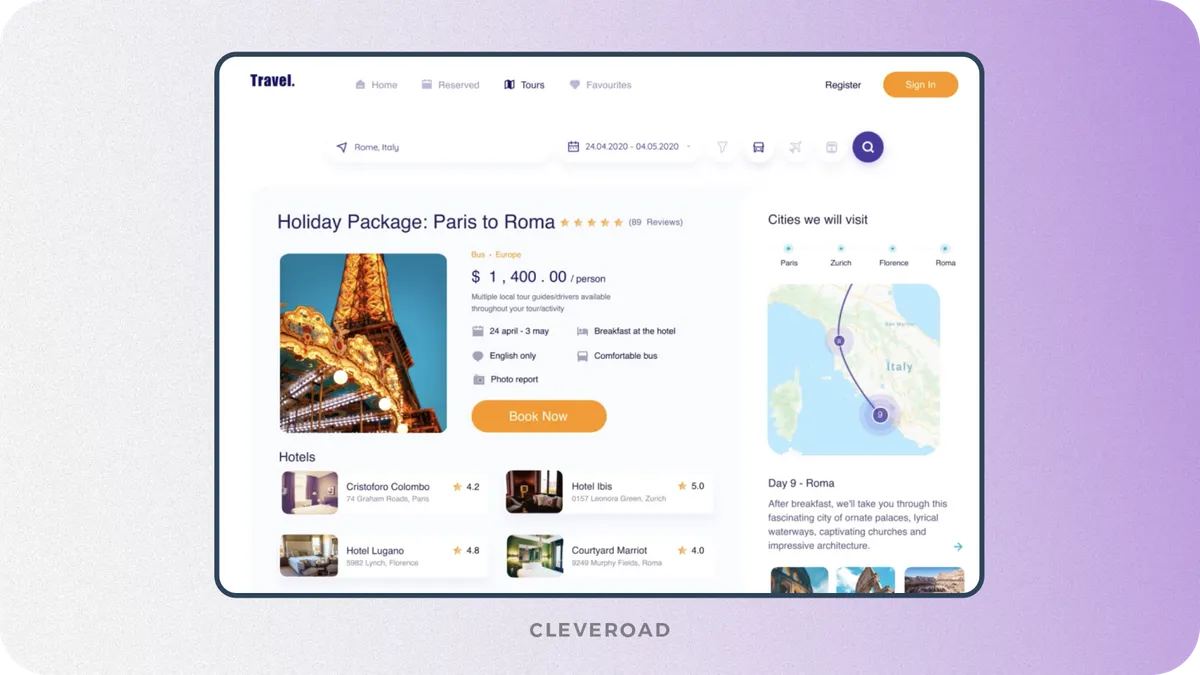
Example of adaptive tour booking platform design developed by Cleveroad (Source: Dribbble)
6. Control travel mobile app development and testing
Our team of expert travel app developers will be by your side throughout the development and testing stage, transforming your travel application concept into a functional reality. During the travel app development process, we leverage Agile development methodology to ensure flexibility and continuous improvement. This means you'll be involved every step of the way, providing feedback and iterating on features to create the perfect travel app.
Rigorous testing is essential, and Cleveroad employs a combination of manual and automated testing to identify and eliminate the developed travel app bugs, performance issues, and usability problems. So, partnering with Cleveroad means your travel app is not only feature-rich but also reliable, high-performing, and ready to impress your target audience.
7. Launch your travel app
Launching your travel app is a critical milestone in the development process. On the day of the travel app launch, the developers and QA engineers (for example, in Cleveroad) ensure your solution is flawless and help you publish it on marketplaces like the App Store and Google Play.
But what should you do next? Consider the following set of activities:
- Ensure your app is available on major app stores like Google Play and the Apple App Store.
- Provide clear instructions and support for users to encourage downloads and positive reviews.
- Monitor the app’s performance post-launch and be prepared to address feedback from early users or solve any issues promptly.
8. Collaborate with the hosts
No fancy how amazing or smooth travel app works for customers if there are no good offers provided. So collaboration with hosts is one of the key points of travel application development. That’s a large amount of data, and hosts are more likely to manage it from an easy-to-use app.
From their account, hotel managers should be able to monitor the bookings, general information, and other details. Another point is a smooth notification system. Besides, customers are likely to blame the app if anything happens during their trip. Make sure you’re choosing trustworthy partners that will follow your agreement.
9. Care about post-launch activities
Post-launch activities are crucial for the ongoing success and improvement of your travel app. Work with your travel app development vendor to continuously monitor app performance and user feedback. Regularly release updates to fix bugs, improve features, and introduce new functionalities. Engage with users through social media, newsletters, and in-app notifications to keep them informed about updates and new features and promote your app. Analyze user behavior and usage patterns to make data-driven decisions for future enhancements. Provide responsive customer support to address any user issues or inquiries promptly.
By following these steps and maintaining close collaboration with your travel and tourism app development vendor like Cleveroad, you can create an app for traveling that meets user needs and excels in the competitive market.
How Travel Apps Make Money
Besides everything else, one of travel apps’ undeniable benefits is their ability to serve as a powerful revenue stream for the travel industry, fostering a win-win situation for both developers and travel businesses. So, we’ll find out how travel apps like Airbnb, Tinder (for traveling), and others make money from a travel experience.
There are the following revenue models for travel and tourism app development:
- In-app purchases (e.g., HotelTonight)
- Premium/Freemium model (e.g., Tinder for traveling)
- Advertising (e.g., Skyscanner)
- Listing charge (e.g., Airbnb)
In-app purchases
In-app purchases offer users the ability to buy additional features or services directly within the app. For travel apps, such as HotelTonight, this could include purchasing premium content such as detailed travel guides, exclusive destination tips, or access to virtual tours.
Users might also pay for enhanced features like offline maps, priority customer support, or travel insurance. This model appeals to users who want more personalized and comprehensive travel planning tools without overwhelming them with upfront costs.
Premium model
The premium model, also known as the freemium model, allows users to use the app basic version of your app after mobile travel app development for free. At the same time, they can offer advanced features (e.g., real-time flight status updates, advanced itinerary management, exclusive travel deals, etc.) through a paid subscription.
Users who see the value in these added features are likely to upgrade, providing a recurring revenue stream. That’s why the premium model for apps like Tinder for Travel ensures a broad user base for the basic travel app while monetizing power users who need additional functionalities.
Advertising
It’s a common monetization strategy where the digital solution displays ads from third-party advertisers. In good travel apps, advertisers could include airlines, hotels, travel agencies, and local attractions. Revenue is typically generated on a per-click (CPC) or per-impression (CPM) basis. While ads can provide a significant revenue stream for travel guide apps like Skyscanner, it’s essential to balance ad placement to avoid disrupting the user experience.
Listing charge
The listing charge model involves charging service providers, such as hotels, tour operators, and local attractions, a fee to be listed on the travel and tourism industry app (e.g., Airbnb). This can be a one-time fee, a subscription fee, or a commission on bookings made through the application for travel. For example, a hotel might pay to be featured prominently in search results or to offer exclusive deals to travel app users. This model creates a symbiotic relationship where service providers gain visibility and potential customers while the app benefits from a steady revenue stream.
Basic Feature Set for Your Travel Application Development
When you use the app, understanding the basic feature set is crucial for maximizing its benefits. Popular travel apps typically include the following features we’ll discover below.
Comprehensive search and filter options
Users should be able to search for flights, accommodations, and activities based on specific criteria such as price, location, dates, and preferences. Filters help narrow down the options, making it easier for users to find exactly what they're looking for. Travel app developers must ensure the search function is fast and accurate, providing relevant results promptly. This feature simplifies the travel planning process and saves users time.
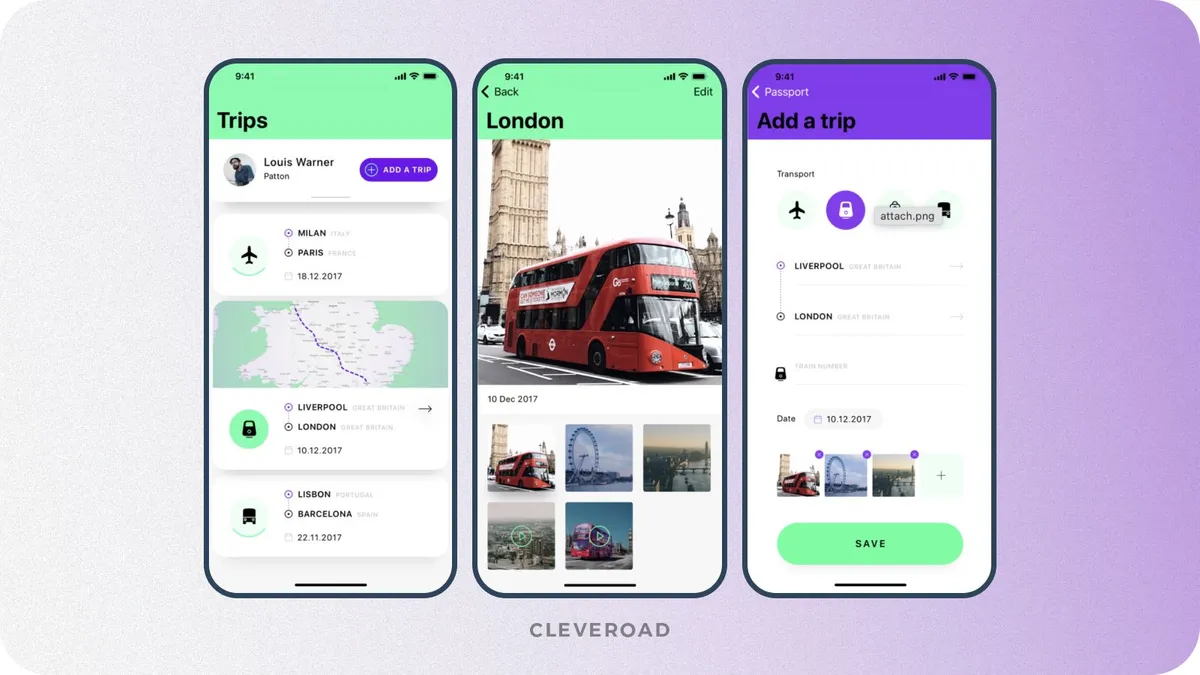
Travel app concept created by Cleveroad team (Source: Dribbble)
Travel itineraries and trip organization
A robust itinerary management feature allows users to create and organize their travel plans in one place. Users can add flights, hotel reservations, activities, and notes, creating a comprehensive travel itinerary. The app should send reminders and notifications earlier implemented by teams in travel app development companies for upcoming bookings and activities. This helps users stay organized and ensures they don't miss any important events during their trip.
Booking and reservation management
The ability to book flights, hotels, car rentals, and activities directly through the app is a must-have. Integrating secure payment gateways and providing users with confirmation and booking details within the app enhances convenience. This feature should also include options to view and manage existing reservations, ensuring users have all their travel details in one place.
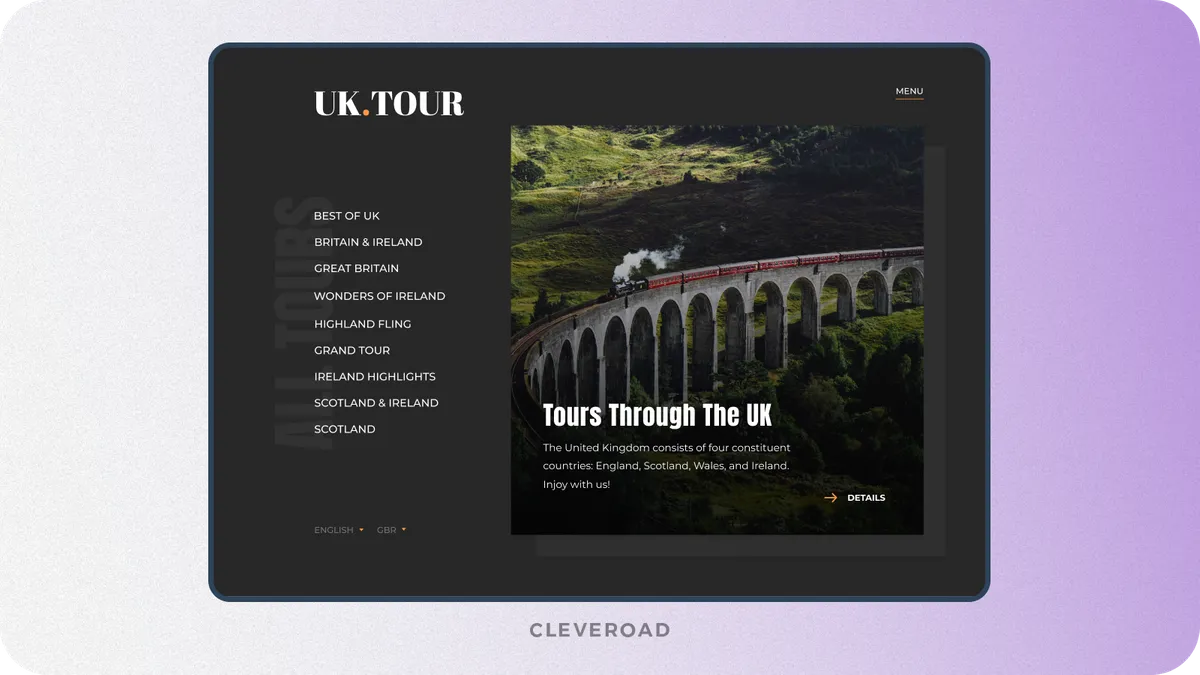
Marketplace for travel agency design created by Cleveroad (Source: Dribbble)
Real-time updates and notifications
Keeping users informed with real-time updates on flight status, weather conditions, and travel advisories is essential. Notifications about gate changes, delays, and cancellations help users stay updated and adjust their plans accordingly. This feature enhances the reliability of the app and provides users with peace of mind knowing they are well-informed throughout their journey.
Offline access
Travelers often find themselves in areas with limited or no Internet connectivity. Providing offline access to essential features such as travel itineraries, maps, and booking details is crucial. This ensures users can still access important information even without an internet connection. Offline access enhances the app's usability and reliability, making it a valuable tool for travelers.
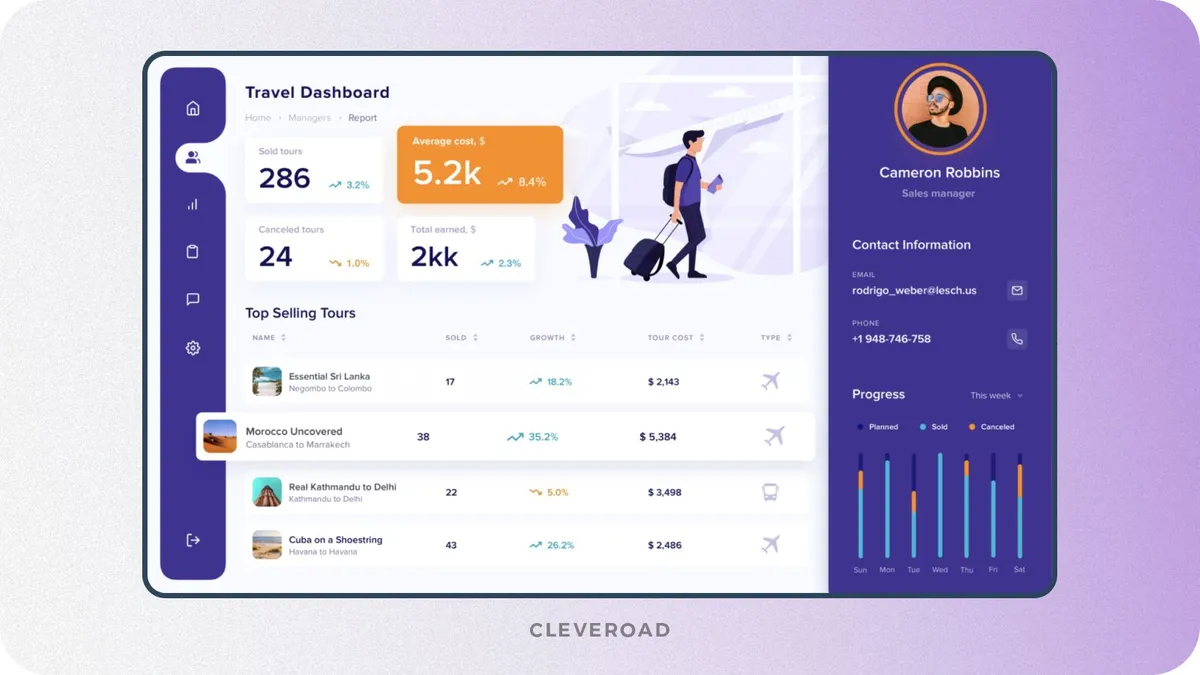
Software for travel agency management built by Cleveroad domain experts (Source: Dribbble)
User reviews and recommendations
Including user-generated reviews and recommendations for hotels, restaurants, and attractions provides valuable insights to other travelers. This feature helps users make informed decisions based on the experiences of others. Travel app developers should ensure the review system is easy to use and offers authentic feedback. This fosters a sense of community within the app and helps users trust the information provided.
Interactive maps and navigation
Integrating interactive maps helps users explore destinations and find attractions, restaurants, and other points of interest. The app should offer turn-by-turn navigation, helping users get to their desired locations efficiently. This feature enhances the travel experience by providing users with valuable information about their surroundings. It's an essential feature for any travel app looking to offer comprehensive travel assistance.
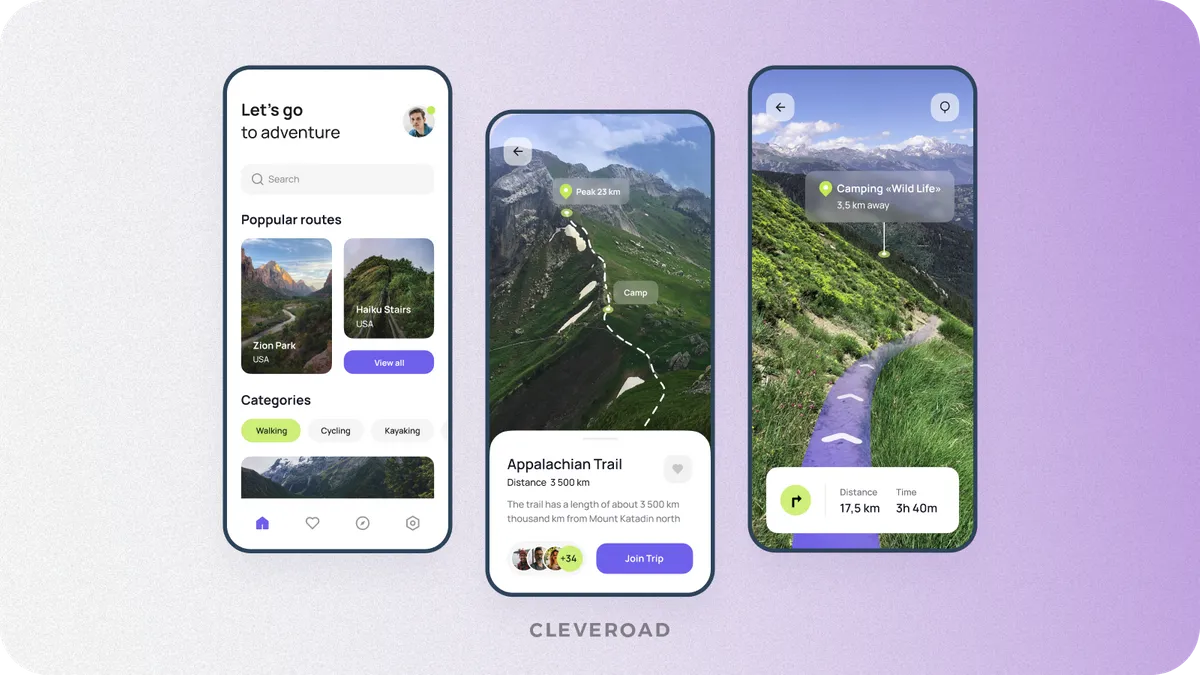
App with routes for travel using Augmented Reality design concept by Cleveroad (Source: Dribbble)
Cost of a Travel App Development
It’s difficult to count the exact cost of travel app development. No vendor can tell it you until they will study your business requirements. Why so? Because the exact mobile travel app development cost depends on many factors, and below, you’ll discover some of the major ones.
App complexity
A basic app with minimal functionality, such as simple search and booking features, requires less time and resources, thus costing less. However, a complex app with advanced features like real-time tracking, multi-language support, and personalized recommendations involves extensive coding, testing, and integration, driving up costs. The need for back-end infrastructure, such as servers and databases, also adds to the complexity.
Moreover, integrating third-party APIs for services like weather updates, currency conversion, and social media sharing further increases the workload. High complexity also demands rigorous testing to ensure reliability and security, contributing to longer development timelines and higher expenses.
Discover more about travel APIs that can enhance travel experience of your hospitality app!
Features choice
Before answering the question “How much does it cost to build an app?”, you should consider the core features of your travel app, like search filters, user registration, and booking capabilities, which are essential and relatively straightforward to implement. Advanced features such as real-time notifications, in-app chat, and AR-based location guides require specialized expertise and additional development time, increasing costs. Futhermore, payment gateway integration for secure transactions also adds complexity and expense.
Furthermore, features like personalized recommendations, loyalty programs, and user reviews necessitate robust data analytics and machine learning capabilities. Each additional feature not only adds to the development cost but also requires ongoing maintenance and updates.
UI/UX design
Investing in travel UI/UX design is crucial for the success of travel app development, but it also influences the cost. For example, custom animations, transitions, and visually appealing elements require skilled designers and developers, leading to higher costs. The design process involves creating wireframes, prototypes, and multiple iterations based on user feedback, which can be time-consuming.
Additionally, optimizing the app for different devices and screen sizes adds to the complexity and cost. A well-designed UI/UX not only enhances user satisfaction but also demands continuous testing and refinement to keep your app up with evolving user expectations and industry standards.
Moreover, designing a travel web app requires attention to responsive design principles to ensure a seamless experience across various browsers and devices. High-quality web app design involves balancing aesthetics with functionality to deliver an intuitive and engaging user experience, which ultimately drives user retention and satisfaction.
Cooperation model choice
There are three popular options for cooperating with software engineers: in-house team, dedicated team, and IT staff augmentation.
The in-house model implies assembling your own development team. However, this hiring option tends to be costly due to additional payments like office rent, hardware, software, taxes, etc. Besides, you should look for specialists competent in developing a mobile app for traveling or pay an expert for assistance because searching for the appropriate developers for your project is a long and difficult.
IT staff augmentation allows you to quickly hire external specialists with expertise in travel app development on a temporary basis. IT staff augmentation services enable you to expand your in-house team with the required tech expert or hire a few specialists who will work only for your product. External developers become full members of your team and follow your corporate culture. The development process and its management are full on your side, but if you need assistance, you can hire an outsourcing Project Manager to work on your product.
The dedicated team model allows you to hire an established team of outsourced experts who will work exclusively on your travel app project. They will manage all the development steps and provide you with reports on project success. This model is gaining popularity due to inexpensive hourly rates, talented developers, and the high quality of the final product. There are many offshore software development companies worldwide so you can hire travel app developers from anywhere for your project. The primary benefit of dedicated development team services is cost flexibility.
You can often reduce costs by choosing outsourced cooperation models, as you don’t have to finance hiring full-time employees or maintaining an in-house team. Another key benefit is more quickly project delivery. Outsourcing companies typically have established procedures and skilled teams that can start the project work immediately. Moreover, outsourcing opens access to large talent pools. You are no longer limited to your region and can hire the experts you want despite your location.
IT vendor's location
Careful selection of partners for software development can lead to cost-effective development without compromising on quality. Development rates vary widely across different regions:
| Region | Travel app developers' hourly rates ($) |
North America | $150-$200 |
Western Europe | $50-$149 |
Cental and Eastern Europe | $25-$49 |
Oceania | $100-$150 |
Asia | $20-$40 |
South America | $25-$49 |
According to this table, you can see the Central and Eastern Europe (CEE) region as one of the most cost-saving. Moreover, it has more benefits except it. Let’s overlook the main of them:
- Strong talent pool. The CEE region boasts a large pool of skilled and experienced software developers with a strong understanding of the latest technologies.
- Cultural proximity. Compared to regions like Asia, Central and Eastern Europe has a closer cultural alignment with Western Europe.
- Time zone overlap. While there might be some time zone difference, it's often manageable compared to regions with significant time zone gaps.
By carefully selecting an outsourcing partner within Central and Eastern Europe, you can leverage the cost benefits while ensuring access to a talented workforce that understands the travel app landscape and can deliver a high-quality product.
Taking into account the functionalities and features, the overall development cost for a travel app can vary from $100,000 to $130,000+. Naturally, this estimate may change based on the specific requirements of your travel app. We recommend to reach out to a travel app development company for a more accurate estimate before moving forward.
Tech Stack For Travel Application Development
Building a high-performance travel app requires leveraging modern technologies to ensure smooth operation and fast load times. For iOS development, Swift remains the leading programming language, offering robust features and seamless integration with Apple's ecosystem. On the Android side, Kotlin and Java are the preferred choices, providing flexibility and efficiency. Additionally, incorporating third-party tools and integrations is essential for enhancing functionality, from booking systems and payment gateways to geolocation services and customer support.
Here’s an example of a project stack that Cleveroad specialists use for travel app development:
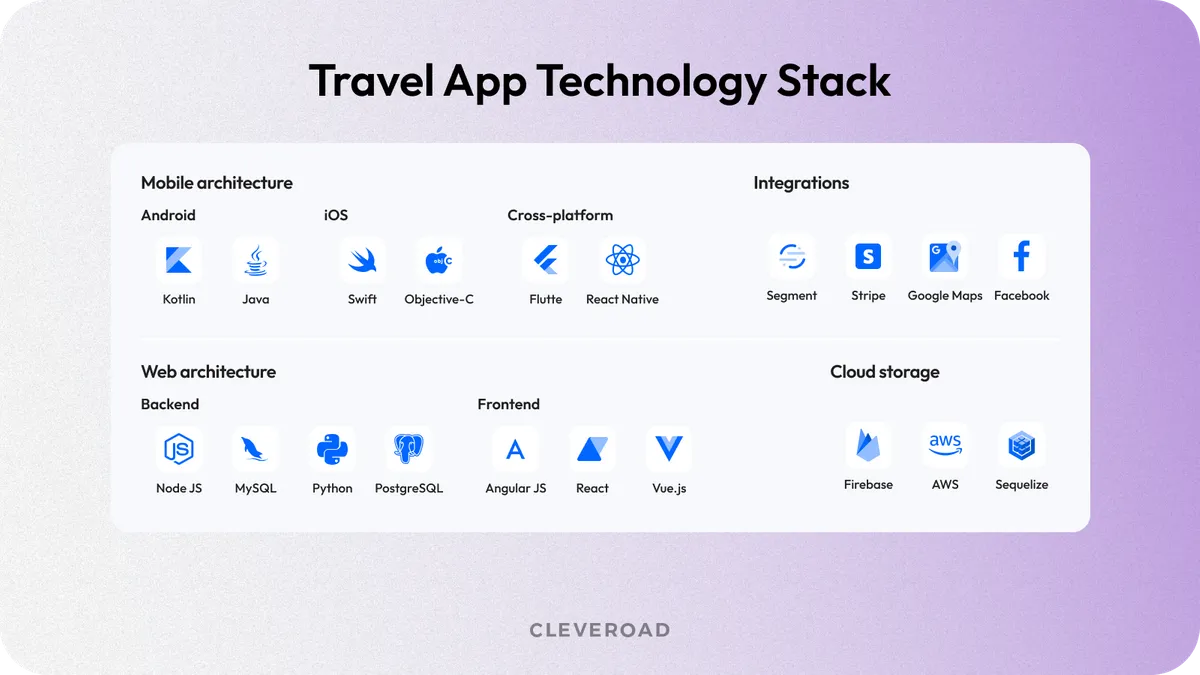
Travel app technology stack that Cleveroad specialists use
Choosing the right technologies aligned with your business goals ensures your mobile travel app development not only meets user needs but also delivers a competitive advantage. And we are ready to help you define these requirements, enhancing your app's market position and driving business growth. Our expertise will make your travel app development process smoother, more efficient, and tailored to achieve your specific business objectives.
Cleveroad Expertise in Travel Mobile Application Development
Cleveroad is a skilled travel app development company working since 2011 with the main office in Estonia and R&D centers in Poland, Ukraine, the US and Norway. We render quality travel and hospitality software development services for airlines, travel agencies, and hotel chains in order to enhance customer engagement and automate domain tasks to streamline the overall workflow.
How can you benefit from travel apps development with us?
- High expertise in building native, web and cross-platform travel apps.
- You can get apps for Android and iOS developed by our experts with the help of the platform-specific programming languages and frameworks like Swift, Kotlin, Flutter, and so on.
- A seamless travel app development with a hands-on expertise in creating domain solutions swiftly and efficiently.
- We offer a free Solution Workshop stage that’s intended to align your travel app concept vision with its appropriate technical implementation.
- Robust and effective quality and security management services which are assured by ISO 9001 and ISO 27001 standard certificates.
- Our Project Management office is ready to oversee your travel app development project to deliver the desired results timely and within your budget.
Let us approve our experience in app development for travel and hospitality business, sharing one of our successfully delivered domain cases with you.
Our client from Denmark applied to Cleveroad and asked us to create a Gym Directory for Travelers called TrainAway. This is a global network of gyms for travelers that makes workouts during trips convenient. This app contains the world’s largest database with 130,000+ gyms worldwide to overcome inconvenience for their customers while searching for gyms abroad.
We required to make this solution attractive and easy to navigate for users. Moreover, it should have allowed the users to pay for gyms through the app, as well as find and offer ones nearby. As a result, the customer received a scalable solution with an extensive worldwide gym database and effectively monetized their business through offering search services to travelers.
Here's how Alexander Schrøder, the owner of TrainAway travel app, has proven the reliability of working on their product with us:


Having successful travel app projects delivered, our domain experts will help you create a tailored solution meeting your business needs and driving growth in the competitive travel industry. You can contact us to start the cooperation on the travel app development.
A travel app is a mobile or web application designed to assist users in planning, booking, and managing their travel experiences. It typically allows users to operate with flight and hotel reservations, itinerary organization, destination guides, and real-time updates on travel conditions. By integrating various travel services and information into one platform, it aims to provide a seamless and convenient experience for travelers.
- Step 1. Define your app purpose.
- Step 2. Conduct market research.
- Step 3. Find an outsourcing travel app development vendor
- Step 4. Select features
- Step 5. Care about UI/UX design
- Step 6. Control travel mobile app development and testing
- Step 7. Launch your travel app
- Step 8. Collaborate with the hosts
- Step 9. Care about post launch activities
Taking into account the functionalities and features, the overall development cost to create travel app can vary from $100,000 to $130,000+. Naturally, this estimate may change based on the specific requirements of your travel app.
The travel app should have such features:
- Comprehensive search and filter options
- Travel itineraries and trip organization
- Booking and reservation management
- Real-time updates and notifications
- Offline access
- Interactive maps and navigation
- User reviews and recommendations
There are the following revenue models for travel and tourism app development:
- In-app purchases (e.g., HotelTonight)
- Premium/Freemium model (e.g., Tinder for traveling)
- Advertising (e.g., Skyscanner)
- Listing charge (e.g., Airbnb)

Evgeniy Altynpara is a CTO and member of the Forbes Councils’ community of tech professionals. He is an expert in software development and technological entrepreneurship and has 10+years of experience in digital transformation consulting in Healthcare, FinTech, Supply Chain and Logistics
Give us your impressions about this article
Give us your impressions about this article
Comments
5 commentsVery nicely explained.
Thanks for sharing wonderful post. It Will very helpful for beginners. Keep writing.
nice and informative article
It's an interesting points you have shared. Thanks for sharing.
Great article. Thanks for sharing
